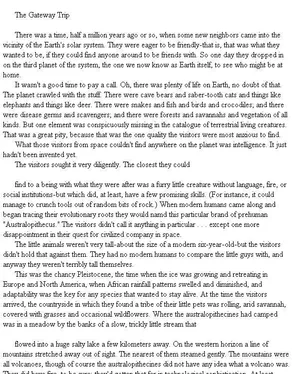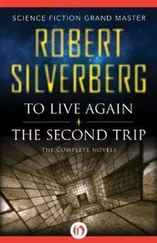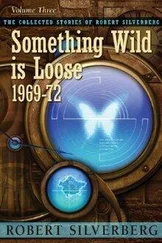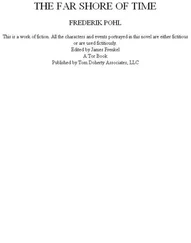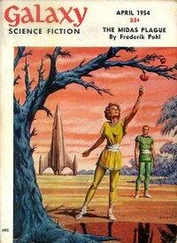Pohl, Frederik - The Gateway Trip
Здесь есть возможность читать онлайн «Pohl, Frederik - The Gateway Trip» весь текст электронной книги совершенно бесплатно (целиком полную версию без сокращений). В некоторых случаях можно слушать аудио, скачать через торрент в формате fb2 и присутствует краткое содержание. Жанр: Старинная литература, на английском языке. Описание произведения, (предисловие) а так же отзывы посетителей доступны на портале библиотеки ЛибКат.
- Название:The Gateway Trip
- Автор:
- Жанр:
- Год:неизвестен
- ISBN:нет данных
- Рейтинг книги:4 / 5. Голосов: 1
-
Избранное:Добавить в избранное
- Отзывы:
-
Ваша оценка:
- 80
- 1
- 2
- 3
- 4
- 5
The Gateway Trip: краткое содержание, описание и аннотация
Предлагаем к чтению аннотацию, описание, краткое содержание или предисловие (зависит от того, что написал сам автор книги «The Gateway Trip»). Если вы не нашли необходимую информацию о книге — напишите в комментариях, мы постараемся отыскать её.
The Gateway Trip — читать онлайн бесплатно полную книгу (весь текст) целиком
Ниже представлен текст книги, разбитый по страницам. Система сохранения места последней прочитанной страницы, позволяет с удобством читать онлайн бесплатно книгу «The Gateway Trip», без необходимости каждый раз заново искать на чём Вы остановились. Поставьте закладку, и сможете в любой момент перейти на страницу, на которой закончили чтение.
Интервал:
Закладка:
Especially with my own private project.
Dorrie couldn't have known just what I wanted to bring Cochenour's body back for. She didn't argue, though. Sick and wretched as she was, she helped me get the cadaver into the airbody lock for the return to the Spindle.
Actually, I wanted that body very much-one piece of it, anyway.
It's not really a new liver, of course. Probably it's not even secondhand. Heaven knows where Cochenour bought it, but I'm sure it wasn't his original equipment.
But it works.
And, bastard though he was, I kind of liked him in a way, and I don't mind at all the fact that I've got a part of him with me always.
The greatest treasure the Heechee tunnels on Venus had to offer had already been discovered, though the first discoverers didn't know it. No one else knew, either-at least, no one except a solitary tunnel-rat named Sylvester Macklin, and he was not in a position to tell anybody what he had found.
Sylvester Macklin had discovered a Heechee spaceship.
If Macklin had reported his find he would have become the richest man in the solar system. He also would have lived to enjoy his wealth. But Sylvester Macklin was as crotchety a loner as any other tunnel-rat, and he did something quite different.
He saw that the ship looked to be in good condition. Maybe, he thought, he could even fly it.
Unfortunately for himself, he succeeded.
Macklin's ship did exactly what any Heechee ship was designed to do, and the Heechee were marvelously great designers. No one knows exactly what processes of thought and experiment and deduction Macklin went through when he blundered onto the wonderful find. He didn't survive to tell anyone. Still, obviously at some point he must have gotten into the ship and closed its hatch and begun poking and prodding at the things that looked as though they ought to be its controls.
As people later well learned, on the board of every Heechee ship is a thing shaped like a cow's teat. It is the thing that makes the ship go. When it is squeezed it is like slipping an automatic-shift car into "drive." The ship moves out. Where it goes to depends on what course was set into its automatic navigation systems.
Mackim didn't do anything about setting any particular cour и, naturally. He didn't know how.
So the ship did what its Heechee designers had programmed it to do in such an event. It simply returned to the place it had come from when its Heechee pilot had left it, half a million years ago.
As it happened, that place was an asteroid.
It was an odd asteroid in several respects. Astronomically it was odd, because its orbit was at right angles to the ecliptic. For that reason, although it was a fair-sized chunk of rock and not far from Earth's own orbit at times, it had never been discovered by human astronomers.
The other odd thing about it was that it had been converted into a sort of parking garage for Heechee spacecraft. In total, there were nearly a thousand of the ships there.
What there was not any of anywhere on the asteroid was anything to eat or drink. So Sylvester Mackim, who could have been
the richest man in history, wound up as just one more starved-to-death corpse.
But before he died Macklin managed to get off a signal to Earth. It wasn't a call for help. No one could reach him in time to save his life. Mackim knew that. He accepted the fact that he would die; he just wanted people to know in what an unsuspected marvel of a place he was dying. And after a while other astronauts, flying the clumsy human rockets of the time, came to investigate.
What they found was the gateway to the universe.
Within the next decade the Gateway asteroid had become the center of mankind's most profitable industry, the exploration of the galaxy.
Macklin didn't own the Gateway asteroid, of course, in spite of the fact that he had discovered it. His luck wasn't that good. He didn't own anything, being dead.
Anyway, it soon became obvious that Gateway was much too important to be owned by any individual, or even by any single nation. The United Nations fought over the question for years, in Security Council and General Assembly-and, more than once, almost with guns and aircraft outside the UN itself. What the world powers wound up with was the Gateway Corporation, a five-power consortium that was set up to control it.
The Gateway asteroid was not a very congenial place for people to live-of course, it had never been designed for human people. It had been designed for the Heechee, and they had stripped it bare before they left. It was a chunk of rock the size of Manhattan, laced through and through with tunnels and chambers and not much else. The thing wasn't even round. One Gateway prospector described it as shaped "more or less like a badly planned pear that the birds had been pecking at." Its internal structure resembled the layers of an onion. The outer shell was where the Heechee ships were docked, their lander ports snuggled into hatch chambers. (Those chambers were the things that looked from the outside like bird peckings.)
Then, inside, there were layers with great open spaces which the humans used for storing supplies and parts, and for the large water reservoir they called "Lake Superior." Closer to the center were the residential tunnels, lined with small rooms like monastery cells, where the humans lived while they waited for their ships. In the heart of the asteroid was a spindle-shaped cavern. The Heechee seemed to like spindle-shaped spaces, though no one knew why. Gateway's tenants used this one for a meeting place-and drinking place, and gambling place, and a place to try to forget what lay ahead of them.
Gateway didn't smell good. Air was precious. It didn't feel good, either, at least not to fresh prospectors just up from Earth. The asteroid had a slow spin, so there was a sort of microgravity, but there wasn't much of it. Anyone who made a sudden move anywhere in Gateway was likely to find himself floating away.
Of course, no one ever looked at the Gateway asteroid as a resort paradise. There was only one reason why any human being would be willing to put up with its expense, its inaccessibility, its discomforts, and its stink, and the reason was the Heechee spaceships.
Flying a Heechee spaceship took a lot of courage, and not much else. Each ship was like every other ship in its class. The biggest of them, the Fives, were not very big-about the same volume of space as a hotel bathroom, and that to be shared by five people. The ships called the Ones (because they could hold only one person for any length of time) were not much bigger than the bathtub itself. Each ship contained a minimum of fittings, and most of the fittings were of unknown importance. There was always a golden coil that seemed to have something to do with the ship's drive, because it was observed to change color at start, finish, and turnaround of each trip. There was always a diamond-shaped golden box about the size of a coffin, too. In a few of the ships there was an even more mysterious
device that looked like a twisted rod of crystal in a black ebon base; it didn't seem to do anything at all (but, as it turned out much later, was capable of some truly astonishing feats). No one knew exactly what was inside any of those things, because whenever anyone tried
to open one it exploded. And then there was the control system, with a curious, painful forked bench to sit on before it. Knurled knobs, flashing lights, the go-teat-they were what made the ship go.
Of course, the ships lacked a great many things that human
beings really didn't want to get along without: the people who ultimately flew them had some human furnishings added, like freezers, more comfortable seats, bunks, cooking tools-and a whole catalogue of cameras, radio antennae, and scientific instruments of all kinds.
Читать дальшеИнтервал:
Закладка:
Похожие книги на «The Gateway Trip»
Представляем Вашему вниманию похожие книги на «The Gateway Trip» списком для выбора. Мы отобрали схожую по названию и смыслу литературу в надежде предоставить читателям больше вариантов отыскать новые, интересные, ещё непрочитанные произведения.
Обсуждение, отзывы о книге «The Gateway Trip» и просто собственные мнения читателей. Оставьте ваши комментарии, напишите, что Вы думаете о произведении, его смысле или главных героях. Укажите что конкретно понравилось, а что нет, и почему Вы так считаете.
